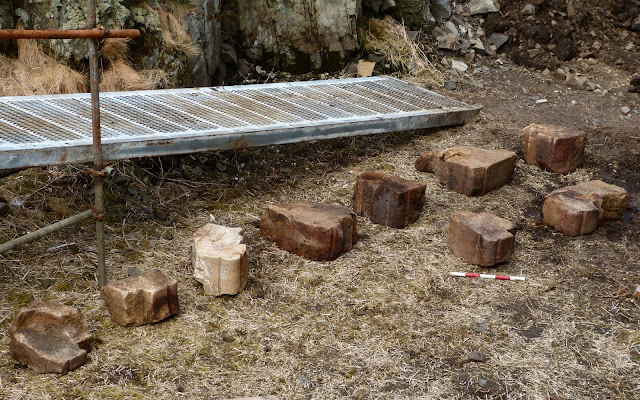Dale Meegan and I, both from the local village of Kilchoan, were today invited to join the work on the site at Mingary Castle by John-Paul Ashley of
Ashley Thompson builders and Tom Addyman of
Addyman Archaeology to get an idea of what a dig was like. It wasn't a gentle conducted tour around the site. After a thorough briefing by Ross Cameron, we were issued with archaeologists' trowels, safety helmets and tabards, brushes, coal shovels and a bucket, and put to work in a corner of the courtyard that's adjacent to the eastern garderobe.
Our task was to remove the rubble which covered a cobbled pavement. Most of the debris had fallen from the walls. It wasn't long before we were uncovering our first finds. This, according to bone expert Dave Henderson who was working beside us and keeping an eye on our activities, is the tibia of a sheep or goat which was under 3 years old.
Dave was working on a particularly interesting section of the cobbled pavement adjacent to the east range as it was thought it might be a drain of some sort. He was also interested in the relationship between the pavement and the range's wall, looking for evidence of which was the older.
Dale and I started at 9.00am, but the archaeologists had arrived long before us. After a brief break at mid-morning, a quick lunch was taken on the grassy slope to the west of the castle. Dave Henderson in the foreground, Tom Addyman at left, Dale and Ross Cameron at right.
After lunch Ross instructed us on the use of the surveying instrument with the ranging poles. He had been working in the west range and wanted to take the exact heights of some twenty points within it. Great credit to Ross for trusting us so quickly with taking the readings.
Our work on the pavement was interrupted during the afternoon by Tom Addyman's discovery of two sandstone blocks in the moat. The one to Tom's left was probably part of the stonework round one of the hall windows as it had a glazing grove, the another - behind Tom's right hand - part of the door frame, possibly part of its arch. These may have been removed from the main range during alterations made late in the 17th century or early in the 18th century, though it's very much a mystery as to why such fine pieces of stone should have been thrown away.
Even though we've had relatively little rain recently, water is constantly coming in to the moat, giving further evidence that it may have been a wet moat rather than a ditch.
By 5.00pm we had, according to Tom, cleared some nine square metres of the cobbled surface. Part of the possible drain that Dave was working on can be seen at right, and the garderobe at top right.
These are some of the fruits of our labours, including bones at right, glass, and pottery at left. My favourite pieces are amongst the pottery at inner left, which Tom Addyman identified as late 18th century 'creamware', including the handle of a small jug at top, and a piece with a rather pretty flower on it at centre.
It was a tremendously enjoyable day during which we learned a huge amount. We thoroughly enjoyed the company and the warm welcome we received from both builders and archaeologists. And it was good, at its end, to look at the area of cleared cobbles with a sense of achievement. Many thanks to all at the site for your kindness.


















































